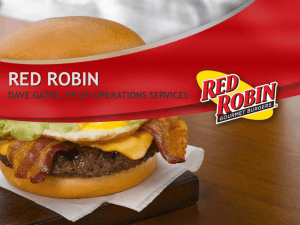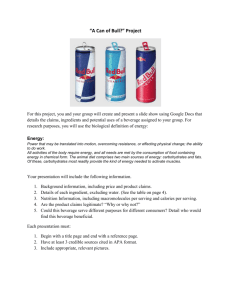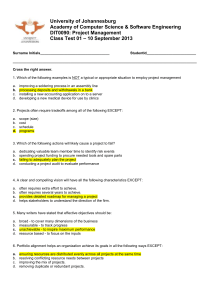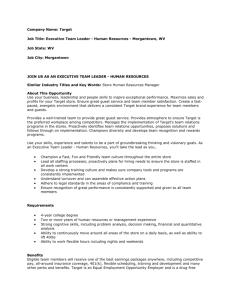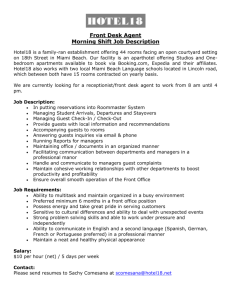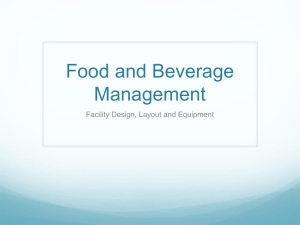Enhanced FBS NC2_POLO
advertisement
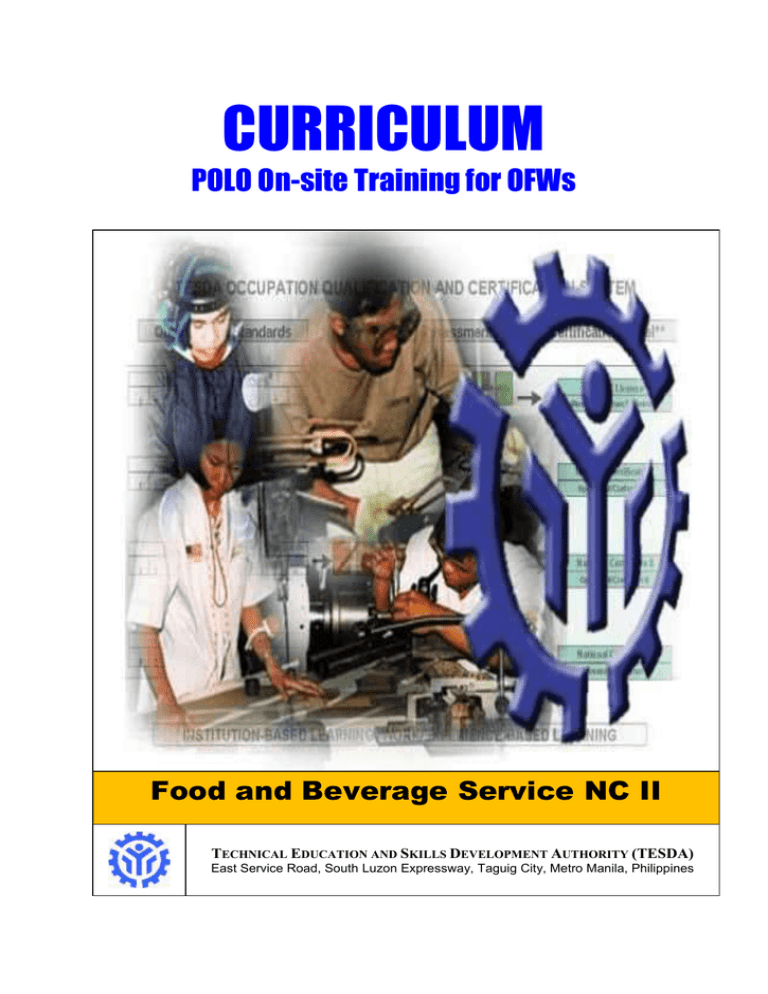
CURRICULUM POLO On-site Training for OFWs Food and Beverage Service NC II TECHNICAL EDUCATION AND SKILLS DEVELOPMENT AUTHORITY (TESDA) East Service Road, South Luzon Expressway, Taguig City, Metro Manila, Philippines CURRICULUM DESIGN FOR FOOD AND BEVERAGE SERVICES NC II (TRSFBS213) FOOD AND BEVERAGE SERVICES NC II The FOOD AND BEVERAGE SERVICES NC II consists of competencies that a person must achieve to provide food and beverage service to guests in various food and beverage service facilities. The Units of Competency comprising this qualification includes the following: TRS512387 Prepare the dining room/restaurant area for service TRS512388 Welcome guests and take food and beverage orders TRS512389 Promote food and beverage products TRS512390 Provide food and beverage services to guests TRS512391 Provide room service TRS512392 Receive and handle guest concerns A person who has achieved this Qualification is competent to be: Waiter Food and Beverage Service Attendant 1 DURATION *NOMINAL ENHANCED COURSE DESIGN Enhanced Course Outline based on TESDA Training Regulations for Food and Beverage Service NC II 1. Prepare the dining room/ restaurant area for service Take table reservation Prepare service stations and equipment Set-up tables in the dining area Set the mood/ambiance of the dining area 64 2. Welcome guests and take 32 food and beverage orders Welcome and greet guests Seat the guest Take food and beverage orders Liaise between kitchen and service 3. Promote food and beverage 32 products Know the product Undertake suggestive selling Carry out upselling strategies 4. Provide food and beverage 144 services to guests Serve food orders Assist the diners Perform banquet or catering food service Serve beverage orders Process payments and receipts Conclude food service and close down dining area Manage intoxicated person Provide room service 32 Take and process room service orders Set up trays and trolleys Present and serve food and beverage orders to guests Suggested Training Methods 2 LectureDiscussion Demonstration Role-Play Audio-visual presentations Visual aids (photos, drawings) LectureDiscussion Demonstration Role-Play LectureDiscussion Role-Play LectureDiscussion AV/Film viewing Demonstration Role-Play LectureDiscussion Demonstration Role-Play CERTIFICATION Food and Beverage Service NC II(TRSFBS213) Prepare the dining room/restaurant area for service (TRS512387) Welcome guests and take food and beverage orders (TRS51238) Promote food and beverage products ((TRS51239) Provide food and beverage services to guests (TRS51240) Provide room service Receive and handle guest concerns Present room service account Clear away room service equipment Receive and handle guest concerns Listen to the complaint Apologize to the guest Take proper action on the complaint Record complaint 16 LectureDiscussion Role-Play * Nominal Duration: is the suggested duration of the training which approximates the time that an average learner can acquire the competency. TRAINING DELIVERY The delivery of training should adhere to the design of the curriculum. Delivery should be guided by the principles of competency-based training. a) Course outline is based on competency standards/training regulations; b) Training delivery is learner-centered and should accommodate individualized and selfpaced learning strategies; c) Training can be done on an actual workplace setting or on a simulated workplace; d) Assessment is based in the collection of evidence of the performance of work; e) Assessment of competency takes the trainee’s knowledge and attitude into account but requires evidence of actual performance of the competency as the primary source of evidence; f) Training program allows for recognition of prior learning (RPL) or current competencies; and g) Training completion is based on satisfactory performance of all specified competencies indicated in the progress chart. TRAINEE ENTRY REQUIREMENTS Trainees or students should possess the following requirements: • Can communicate in Basic English either oral or written; • Can perform basic mathematical computation 3 RECOMMENDED LIST OF TOOLS, SUPPLIES AND MATERIALS FOR TEN (10) TRAINEES Quantity GLASSWARE 2 4 4 Unit Description pcs Water goblets pcs pcs high ball/Collin glasses 1 pc red and white wine glasses sparkling wines 2 1 pcs pcs champagne glasses double lever cork screw DINING ROOM FURNITURE’S 1 1 4 unit pc pcs Service Station Square Tabe Dining room chairs 2 2 pcs pcs 2 pcs Square table cloth Service napkin (12” x 12”) / Hand towels Cleaning cloth (good morning towels top cloth LINENS DINNER WARE 1 2 2 pc pcs pcs Cover / show plate (12” in diameter) Bread and butter plate (6” in diameter) soup plate with w/salad plates, fish plates and dinner plates pcs pcs pcs pcs pcs pcs pcs pcs Dinner knives Dinner forks Bread and butter knives fish fork Fish Knives Soup spoon Teaspoon Dessert spoon SILVERWARE 4 4 4 4 4 4 4 4 OTHER MISE-EN-PLACE 1 pc 1 pc 1 pc 1 pc 1 pc Bar tray Service tray Stainless pitcher Flower vase Salt and pepper shaker 4 TRAINING FACILITIES Based on a class intake of 25 students/trainees. It may vary depending on the number of students/trainee Space Requirement Size in Meters Area in Sq. Meters Total Area in Sq. Meters Student/Trainee Working Space 1 x 1 m. 1 sq. m. 25 sq. m (8 x 5 m.)x2 (40sq.m.)x2 (40 sq. m).x2 Laboratory 8 x 5 m. 40 sq. m. 40 sq. m. Learning Resource Center Facilities/Equipment/ Circulation Area 3 x 5 m. 15 sq. m. 15 sq. m. Lecture/Demo Room 36 sq. m. Total workshop area: 156 sq. m. +40sq.m. TRAINER’S QUALIFICATIONS Trainers shall be required to be certified to the National Certificate for which qualification they will train. TESDA shall provide an online training on Plan Training Session and Facilitate Learning Sessions to the potential trainers.1 Minimum requirements: ➢Holder of a National Certificate in the Qualification s/he will teach; and ➢ Has completed the following units of Trainer’s Methodology Level I: I. II. Plan Training Sessions; • Identifying learner’s training requirements • Prepare session plan • Prepare instructional materials • Prepare assessment instruments (Institutional) • Organize learning and teaching resources; and Facilitate Learning Sessions • Prepare training facilities /resources • Conduct pre-assessment • Facilitate training session • Conduct competency assessment • Review delivery of training session 1 (The training modules corresponding to the above units of Trainer’s Methodology can be accessed through the TESDA-NITESD website.) 5 MEASUREMENT OF ACHIEVEMENT OF COMPETENCY Practical demonstration with oral questioning RECOMMENDATIONS FOR ASSESSMENT AND CERTIFICATION 1. Prior to competency assessment for Food and Beverage Service NC II, please accomplish the Self-Assessment Guide (SAG) to determine readiness for assessment 2. Submit accomplished SAG to POLO staff in- charge for advice 6 COMPETENCY-BASED CURRICULUM FOOD AND BEVERAGE SERVICE NC II TRS512387 Prepare the dining room/restaurant area for service TRS512388 Welcome guests and take food and beverage orders TRS512389 Promote food and beverage products TRS512390 Provide food and beverage services to guests TRS512391 Provide room service TRS512392 Receive and handle guest concerns 7 UNIT OF COMPETENCY : PREPARE THE DINING ROOM/RESTAURANT FOR SERVICE UNIT CODE : TRS512387 MODULE TITLE : PREPARING THE DINING ROOM/RESTAURANT FOR SERVICE MODULE DESCRIPTION : This module covers the knowledge and skills required in the preparation of the dining room /restaurant area before the start of the service operations. It involves opening duties or the dining room mise-en-place prior to service. NOMINAL DURATION : 62 hours SUMMARY OF LEARNING OUTCOMES: At the completion of the module the trainees/students should be able to: LO1 Take table reservations LO2 Prepare service station and equipment LO3 Set up tables in the dining area LO4 Set the mood/ambiance of the dining area LO1. TAKE TABLE RESERVATIONS ASSESSMENT CRITERIA: 1. Inquiries are answered based on food enterprise’s standards. 2. Pertinent questions are asked to complete the details of the reservations. 3. Reservations data are recorded based on enterprise standards. 4. Details of the reservations are confirmed with the party making the reservation. 5. Additional information about the foodservice enterprise is provided CONTENTS: Dealing with clients How to take table reservations - Telephone - Internet (web site, email) - Walk-in Telephone Courtesy Recording of reservations and communicating information to people concerned Daily menu METHODOLOGIES: Lecture-discussion Demonstration Role play ASSESSMENT METHODS: Simulation / practical test Oral questioning 8 Written exam LO2. PREPARE SERVICE STATIONS AND EQUIPMENT ASSESSMENT CRITERIA: 1. Supplies are made available at service or waiter’s stations. 2. Tableware and dining room equipment are cleaned according to food enterprise standards. 3. Tent cards and similar special displays are put up for promotion as per marketing requirements. 4. Cleanliness of tables, tableware and dining room equipment are checked as per food enterprise standards. 5. Water pitchers and ice buckets are filled as per service requirements. 6. Electrical appliances in the dining area are turned on and kept ready. 7. Condiments and sauce bottles are refilled and the necks and tops of the bottles are wiped clean and dry. CONTENTS: Station mise-en-place o Cleaning procedure of tableware o Cleaning of dining room equipment Opening duties of foodservice staff METHODOLOGIES: Lecture-discussion Demonstration with return demo ASSESSMENT METHODS: Simulation / practical test Oral questioning Written exam LO3. SET UP THE TABLES IN THE DINING AREA ASSESSMENT CRITERIA: 1. Table cloths are laid according to food enterprise standards. 2. Tables are set according to cover and predetermined menu. 3. Tableware and glassware are cleaned and set up according to food enterprise standards. 4. Cloth napkins are folded according to napkin folding style. 5. Buffet or display tables are skirted in accordance to standard table set up. 6. Tables are set up according to event and functions requirements. CONTENTS: 9 Tableware identification - Dinnerware - Flatware/Silverware - Beverageware/Glassware - Holloware Clothing tables Setting the table (General principles in laying covers) Types of table Napkin folding styles How to set up banquets (including skirting) METHODOLOGIES: Lecture-discussion Demonstration with return demo Film showing Visual aids like photos, lay outs, floor plans and drawings ASSESSMENT METHODS: Simulation / practical test Oral questioning Written exam LO4. SET THE MOOD/AMBIANCE OF THE DINING AREA ASSESSMENT CRITERIA: 1. Lights are adjusted according to diners’ preference. 2. Tables, chairs and other dining room furniture are arranged to ensure comfort and convenience of the guests. 3. Music is played according to event requirements. 4. Floors/carpets are cleaned according to food enterprise standards. 5. Air-condition or cooling units are adjusted for guests’ comfort. 6. Decorations are set-up according to theme or events. CONTENTS: Elements of setting the ambiance of the dining area Dining procedures in setting the mood and ambiance of the dining area Lighting adjustment Operating audio visual equipment Cleaning procedures on floors/carpet Temperature setting Music vs events Decorations vs events METHODOLOGY: Lecture-discussion Demonstration with return demo 10 Film showing Visual aids like photos, lay outs, floor plans and drawings ASSESSMENT METHODS: Written or oral test Simulation/practical test Oral questioning 11 UNIT OF COMPETENCY : WELCOME GUESTS AND TAKE FOOD AND BEVERAGE ORDERS UNIT CODE : TRS512388 MODULE TITLE : WELCOMING GUESTS AND TAKING FOOD AND BEVERAGE ORDERS MODULE DESCRIPTION : NOMINAL DURATION : This module deals with the knowledge and skills required in providing pre-meal services to the dining guests as soon as they arrive in the foodservice facility. It covers the dining room or restaurant service procedures before the food and beverage orders are served. 24 hours SUMMARY OF LEARNING OUTCOMES: At the completion of the module the trainees/students should be able to: LO 1 Welcome and greet guests LO 2 Seat the guests LO 3 Take food and beverage orders LO 4 Liaise between kitchen and dining area LO1. WELCOME AND GREET GUESTS ASSESSMENT CRITERIA: 1. Guests are greeted according to enterprise welcome procedures. 2. Details of reservations are checked based on enterprise standard policy. CONTENTS: Welcoming and greeting procedures Communication skills METHODOLOGIES: Lecture-discussion Demonstration with return demo Film showing Visual aids like photos, lay outs, floor plans and drawings ASSESSMENT METHODS: Oral questioning Simulation Practical test with oral questioning LO2. SEAT THE GUESTS ASSESSMENT CRITERIA: 12 1. 2. 3. 4. 5. Guests are escorted and seated according to table assignment. Tables are utilized according to number of guests’. Guests are seated evenly to control the traffic flow in the dining area. Cloth napkins are opened according to procedure requirements. Water is served according to the standards of the foodservice facility. CONTENTS: How to seat guests Where to seat guests (controlling traffic flow of guests) Opening napkins for guests Procedure in serving water METHODOLOGIES: Lecture-discussion Demonstration with return demo Film showing Visual aids like photos, lay outs, floor plans and drawings ASSESSMENT METHODS: Oral questioning Simulation Practical test with oral questioning LO3. TAKE FOOD AND BEVERAGE ORDERS ASSESSMENT CRITERIA: 1. Menu is presented to guest according to enterprise standard practice. 2. Information about house specials is provided in clear explanations and descriptions. 3. Orders are taken in accordance with the enterprise standard procedures. 4. Orders are repeated back to the guests to confirm items. 5. Recommendations and suggestions are made to assist customers with drink and meal selections. 6. Customer questions on menu items are answered according to established standard practice. 7. Special requests and requirements are noted accurately. 8. Tableware and cutlery for the menu choices are adjusted in accordance with enterprise procedures. CONTENTS: Types of Menu Menu Familiarization Presenting the menu 13 Taking food and beverage orders Suggestive selling Providing advice on food Providing advice on wine METHODOLOGIES: Lecture-discussion Demonstration Role play ASSESSMENT METHODS: Simulation/practical test with oral questioning Oral or written test LO4. LIAISE BETWEEN THE KITCHEN AND THE DINING AREA ASSESSMENT CRITERIA 1. Orders are placed and sent to the kitchen in accordance with enterprise procedure. 2. Quality of food is checked in accordance with enterprise standards. 3. Tableware is checked for chips, marks, cleanliness, spills, and drips. 4. Plates and/or trays are carried out safely. 5. Readiness of items for service in accordance with enterprise procedure. 6. Special requests, dietary or cultural requirements are relayed as to guests’ preference. 7. Work technologies are observed according to enterprise standard policy and procedures. CONTENTS: Liaising between the kitchen and the dining area (Interdepartmental communication) Teamwork Types of food establishment work technology METHODOLOGIES: Lecture-discussion Demonstration Role play ASSESSMENT METHODS: Simulation/practical test with oral questioning Oral or written test 14 UNIT OF COMPETENCY : PROVIDE FOOD AND BEVERAGE SERVICE TO GUEST UNIT CODE : TRS512390 MODULE TITLE : PROVIDING FOOD AND BEVERAGE SERVICE MODULE DESCRIPTION : NOMINAL DURATION : This module deals with the knowledge and skills required in the provision of food and beverage service to guests in various types of dining venues and diverse styles of service. 148 hours SUMMARY OF LEARNING OUTCOMES: LO1 LO2 LO3 LO4 LO5 At the completion of the module the trainees/students should be able to: Serve food orders Assist the diners Perform banquet or catering food service Serve beverage orders Conclude food service and close down dining area LO1. SERVE FOOD ORDERS ASSESSMENT CRITERIA: 1. Food orders are picked up and checked according to enterprise standard. 2. Foods are served according to table assignment in accordance with enterprise standards and hygiene requirements. 3. Food orders are served according to diners’ preferred serving styles. 4. Dish is described to the guest(s) according to its components and nutritive value. 5. Sequence of service and meal delivery is monitored in accordance with enterprise procedures. CONTENTS: Sequence of Service Types of Tableware Foodservice Styles Menu Components Nutritional Value Food Service Procedures Serving Techniques Food Safety Principles 15 METHODOLOGIES: Lecture-discussion AV presentation/film viewing Demonstration Role play ASSESSMENT METHODS: Simulation/practical test with oral questioning Oral or written test LO2. ASSIST THE DINERS ASSESSMENT CRITERIA: 1. Additional food and beverage are offered and served according to order. 2. Condiments and tableware are provided based on the food order. 3. Delays in service are followed up based on enterprise policy. 4. Water, bread, and butter are replenished according to food enterprise policy. 5. Attention and care are given to diner(s) with special needs. CONTENTS: Assisting the Guests During Meals Serving Diners with Special Needs Condiments Tableware Complimentary Foods Guests With Special Needs METHODOLOGIES: Lecture-discussion AV presentation/film viewing Demonstration Role play ASSESSMENT METHODS: Simulation/practical test with oral questioning Oral or written test LO3. PERFORM BANQUET OR CATERING FOOD SERVICE ASSESSMENT CRITERIA: 1. Banquet service ware are prepared and checked according to food enterprise policy. 2. Tables and chairs are set up as per instructions of the Banquet Captain or as per event order form. 3. Table linens are laid out in accordance with food enterprise procedures. 4. Food is handled and served according to food enterprise policy. 5. Coordinated service of meal courses is ensured according to food enterprise policy. 16 6. 7. 8. 9. Assigned areas are kept clean in accordance with food enterprise standards. Tables are cleared according to food enterprise procedures. Dishes are stacked for dishwashing according to food enterprise procedures. Banquet and catering food service is documented according to food enterprise procedures. CONTENTS: Banquet Function/On or Off Premise Catering Duties and Responsibilities Of Banquet Service Staff Banquet Event Order Food Safety Food Enterprise Standards, Procedures and Policies METHODOLOGIES: Lecture-discussion AV presentation/film viewing Demonstration Role play ASSESSMENT METHODS: Simulation/practical test with oral questioning Oral or written test LO4. SERVE BEVERAGE ORDERS ASSESSMENT CRITERIA: 1. Beverage orders are picked up using standard service tray. 2. Beverage orders are checked for presentation and appropriate garnishes. 3. Beverage garnishes are checked in accordance with food enterprise standards. 4. Beverages are served according to enterprise standards of service. 5. Beverages are served at the right temperature. 6. Wine is opened according to food enterprise procedures. 7. Wine service is carried out in accordance with food enterprise procedures. 8. Beverages are served with accompaniments following food enterprise standards. CONTENTS: Types of beverage/glassware (review) Beverage service Garnishes for Beverages Wine Service How to open wine bottles METHODOLOGIES: Lecture-discussion Demonstration Audio visual presentation/film viewing 17 Role play ASSESSMENT METHODS: Simulation/practical test with oral questioning Oral or written test LO5. CONCLUDE FOOD SERVICE AND CLOSE DOWN DINING AREA ASSESSMENT CRITERIA: 1. Soiled dishes are removed according to enterprise standards of service. 2. Billings are presented to the diners according to food enterprise billing procedure. 3. Payment is acknowledged as soon as it is received. 4. Tables are cleared and reset according to food enterprise procedure. 5. Closing down activities is performed according to food enterprise procedure. CONTENTS: Clearing the Table Re-setting the Table Presenting the Bill Bidding the Diner Good bye METHODOLOGIES: Lecture-discussion Demonstration Audio visual presentation/film viewing Role play ASSESSMENT METHODS: Simulation/practical test with oral questioning Oral or written test 18 UNIT OF COMPETENCY : PROVIDE ROOM SERVICE UNITCODE : TRS512391 MODULE TITLE : PROVIDING ROOM SERVICE MODULE DESCRIPTOR : NOMINAL DURATION : This module deals with the knowledge and skills required in the provision of food and beverage service particularly in the guest room of a commercial accommodation enterprise. 32 hours SUMMARY OF LEARNING OUTCOMES: Upon completion of this module, the trainee/ student must be able to: LO1. Take and process room service orders LO2 Set-up trays and trolleys LO3 Present and serve food and beverage orders to guests LO4 Present room service account LO5 Clear away room service equipment LO1. TAKE AND PROCESS ROOM SERVICE ORDERS ASSESSMENT CRITERIA: 1. Telephone call is answered in accordance with customer service standards. 2. Guest’s name is checked according to enterprise standards. 3. Details of order are clarified, repeated, checked and recorded according to enterprise procedures. 4. Suggestive selling techniques are used according to enterprise standard. 5. Guests are advised of approximate time of delivery. 6. Doorknob dockets are interpreted in accordance to enterprise standards. 7. Orders are relayed for preparation following food enterprise procedure. CONTENT: Taking Room Service Orders a. Telephone b. Doorknob Dockets c. Suggestive Selling Techniques METHODOLOGIES: Lecture-discussion Demonstration Role play ASSESSMENT METHODS: Simulation/practical test with oral questioning Oral or written test 19 LO2. SET-UP TRAYS AND TROLLEYS ASSESSMENT CRITERIA: 1. Room service equipment and supplies are prepared in accordance with enterprise procedures. 2. Room service equipment and supplies are selected and checked for cleanliness and condition. 3. Trays and trolleys are set up according to food enterprise standard. 4. Room service trays or trolleys are set up according to the food and beverage ordered. 5. Orders are checked before leaving the kitchen for delivery. 6. Food items are covered during transportation to the room. 7. Food orders must be delivered on the time desired by the guest CONTENTS: Equipment and Material Selection Trolley Set Up Setting Room Equipment and Supplies Setting Room Service Trays or Trolleys METHODOLOGIES: Lecture-discussion Demonstration Role play ASSESSMENT METHODS: Simulation/practical test with oral questioning Oral or written test LO3. PRESENT AND SERVE FOOD AND BEVERAGE ORDERS TO GUESTS ASSESSMENT CRITERIA: 1. Room service delivery is performed following room service standard procedure. 2. Guests are greeted politely in accordance with the with enterprise service procedures. 3. Food orders are set up according to diners’ preference. CONTENT: Room Service Meal Delivery and Serving Room Service Standard Procedures METHODOLOGIES: Lecture-discussion Demonstration Role play 20 ASSESSMENT METHODS Simulation/practical test with oral questioning Oral or written test LO4. PRESENT ROOM SERVICE ACCOUNT ASSESSMENT CRITERIA: 1. Guests’ accounts are checked for accuracy and presented in accordance with enterprise procedures. 2. Cash payments are presented to the cashier for processing in accordance with enterprise guidelines. 3. For charge accounts, guests are asked to sign the bill. CONTENT: Presenting the Bill Types of Payment o Cash o Charge o Credit Card o Cheque Processing Payments METHODOLOGIES: Lecture-discussion Demonstration Role play ASSESSMENT METHODS: Simulation/practical test with oral questioning Oral or written test LO5. CLEAR AWAY ROOM SERVICE EQUIPMENT ASSESSMENT CRITERIA: 1. Tray and trolley are cleared following food enterprise procedure. 2. Floors are checked and cleared in accordance with food enterprise policy and guidelines. 3. Trays and trolleys are cleaned and returned to the room service area following food enterprise procedure. 21 CONTENT: Clearing Room Service Equipment Cleaning Room Service Equipment Cleaning Floor Area METHODOLOGIES: Lecture-discussion Demonstration Role play ASSESSMENT METHODS: Simulation/practical test with oral questioning Oral or written test 22 UNIT OF COMPETENCY : RECEIVE AND HANDLE GUEST CONCERNS UNIT CODE : TRS512392 MODULE TITLE : RECEIVING AND HANDLING GUEST CONCERNS MODULE DESCRIPTOR : receiving NOMINAL DURATION : This module deals with the knowledge and skills required in and handling guest complaints/concerns. 16 hours SUMMARY OF LEARNING OUTCOMES: LO1. LO2 LO3 LO4 Upon completion of this module, the trainee/ student must be able to: Listen to the complaint/concern Apologize to the guest Take proper action on the complaint/concern Record complaint LO1. LISTEN TO THE COMPLAINT/CONCERN ASSESSMENT CRITERIA 1. Information about the complaint/concern is gathered and noted following enterprise procedures. 2. Attention is given to the complainant following enterprise policy. 3. Guests’ complaint/concern is analyzed and evaluated in accordance with enterprise policy. CONTENTS: Listening skills Summarizing information Handling complaints/concerns METHODOLOGIES: Lecture-discussion Role play ASSESSMENT METHODS: Simulation/practical test with oral questioning Oral or written test LO2. APOLOGIZE TO THE GUEST ASSESSMENT CRITERIA: 1. Sincere apology is offered for the disservice. 23 2. Empathy is shown to the guest to show genuine concern and consideration. 3. Excuses or blaming others are avoided. 4. Gratitude is expressed to the guest for bringing the matter up for attention. CONTENT: Customer Relations METHODOLOGIES: Lecture-discussion Role play ASSESSMENT METHODS: Simulation/practical test with oral questioning Oral or written test LO3. TAKE PROPER ACTION ON THE COMPLAINT ASSESSMENT CRITERIA: 1. Persons or department concerned are informed about the complaint. 2. Serious problems/concerns are referred to higher authority for action. 3. Problems are followed-up to check whether it is solved or not. CONTENTS Customer Relations Handling Complaints Problem Category METHODOLOGIES: Lecture-discussion Role play ASSESSMENT METHODS: Simulation/practical test with oral questioning Oral or written test LO4. RECORD COMPLAINT ASSESSMENT CRITERIA: 1. Complaints are documented according to the enterprise standard procedures. 2. Persons concerned are recognized and actions taken are recorded. 3. Feedback received from guests is logged and collated. CONTENTS: Records Keeping/Documentation Feed Backing Skills 24 METHODOLOGIES: Lecture-discussion Role play ASSESSMENT METHODS: Simulation/practical test with oral questioning Oral or written test 25
